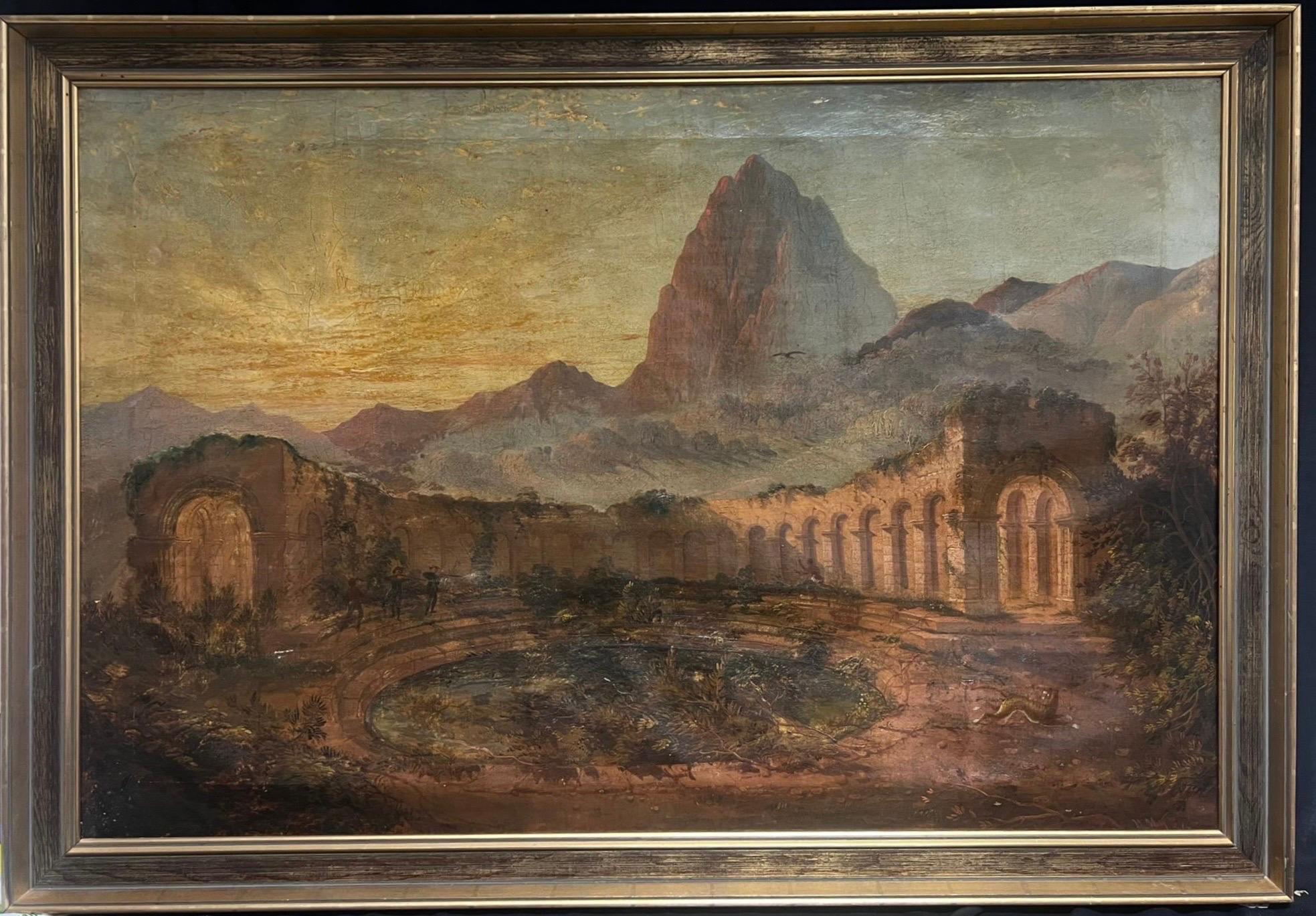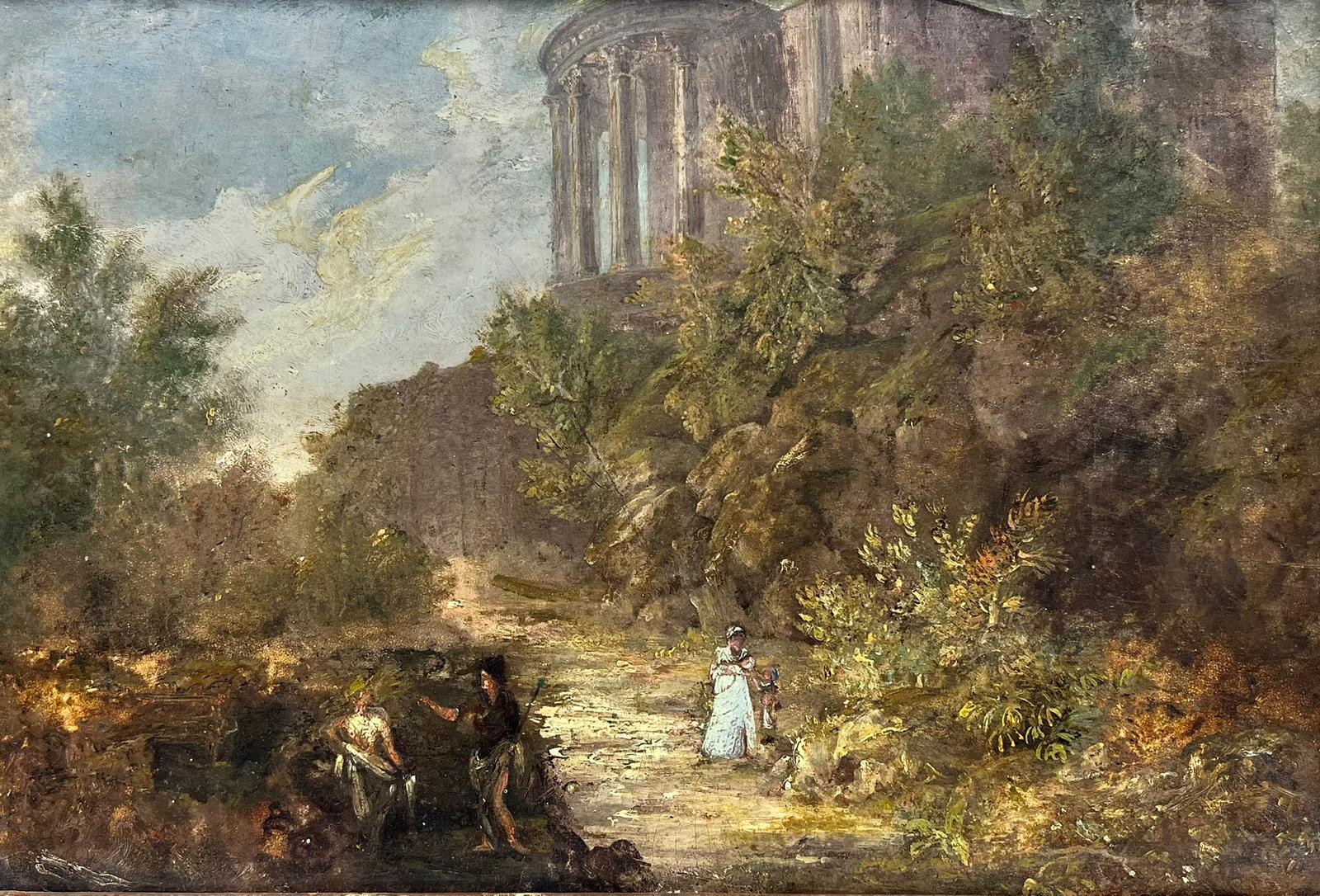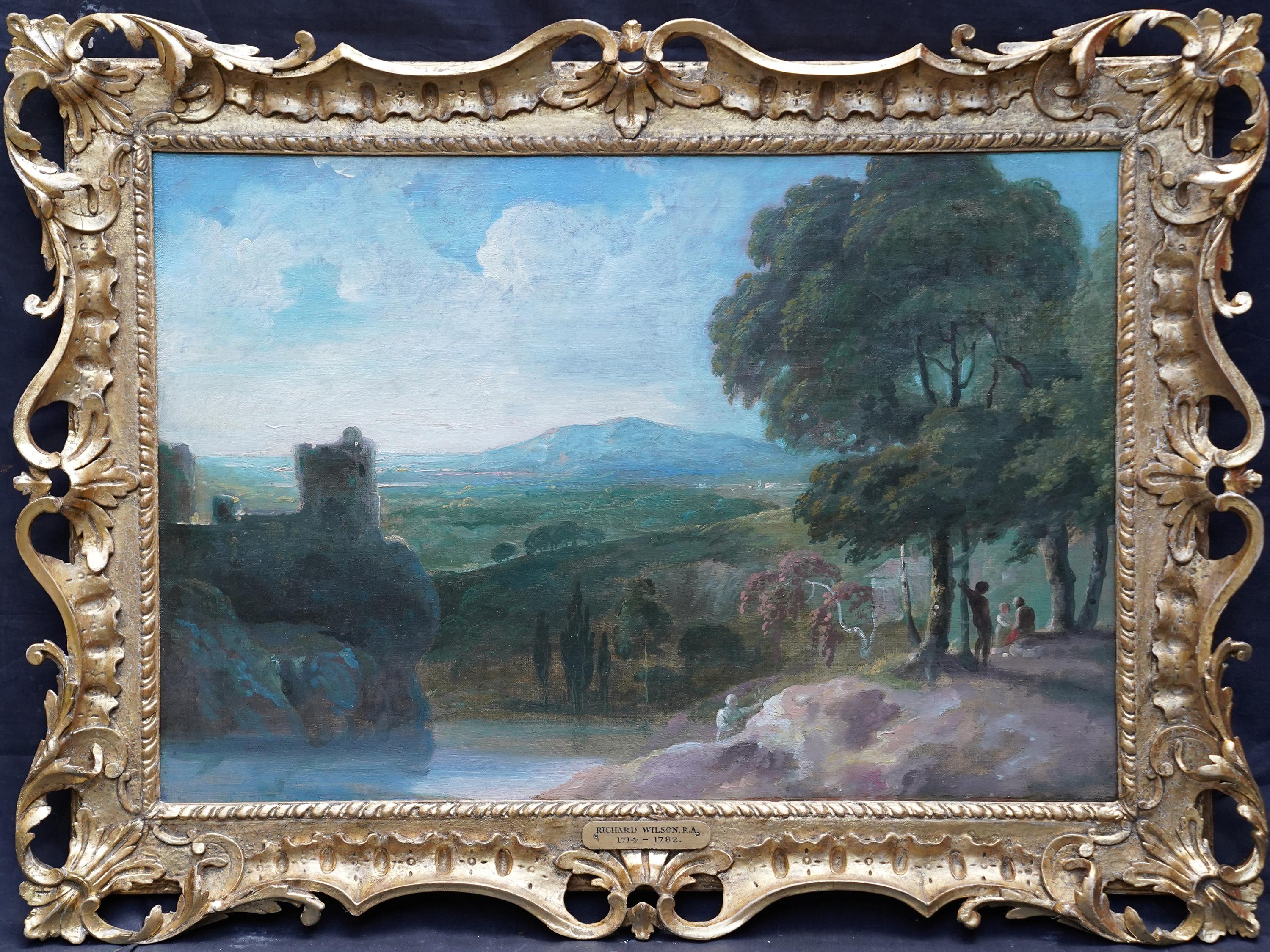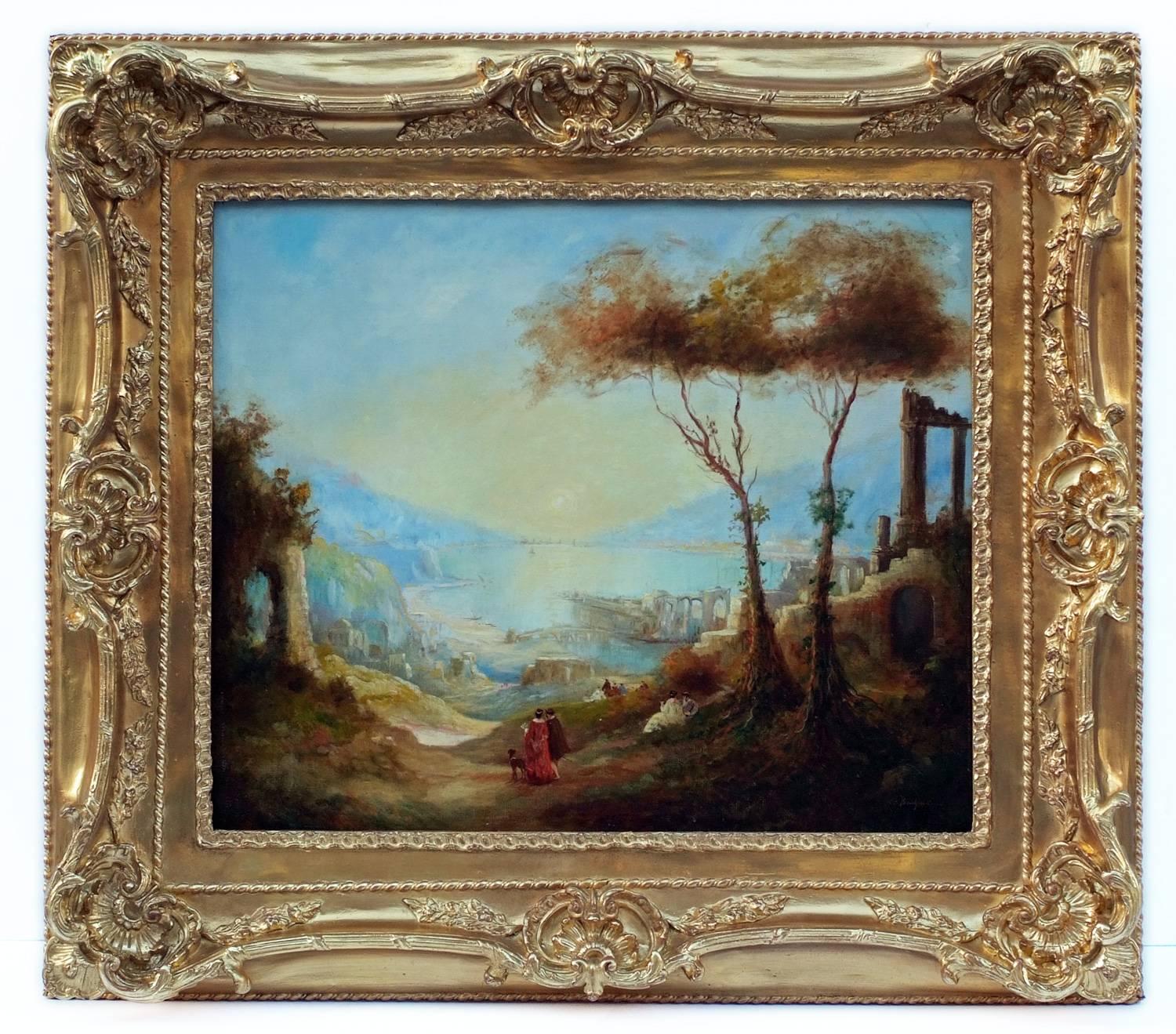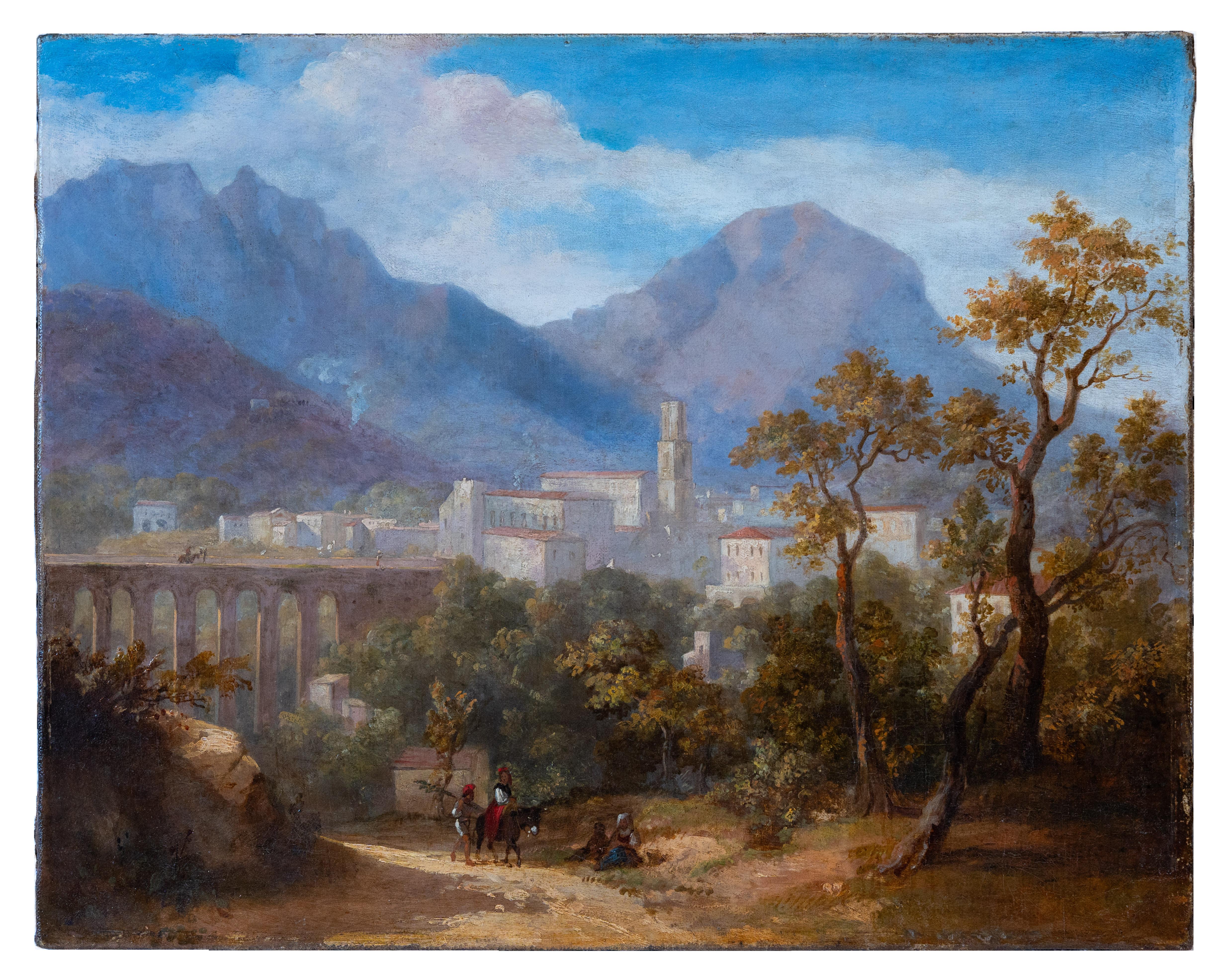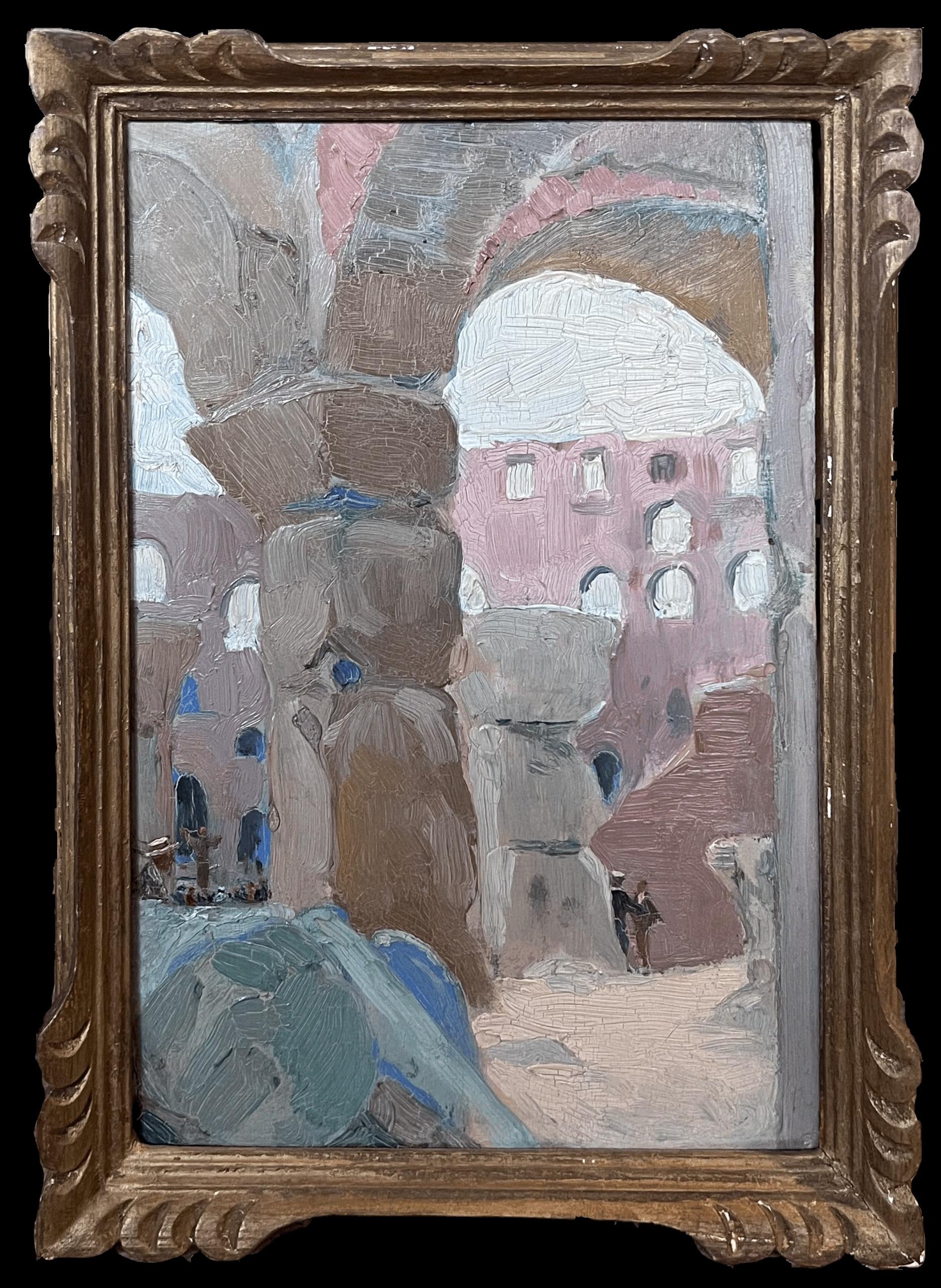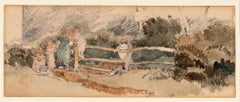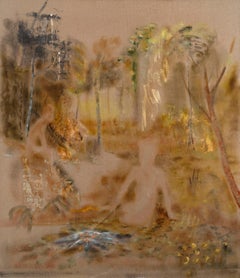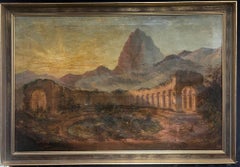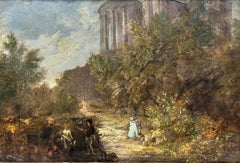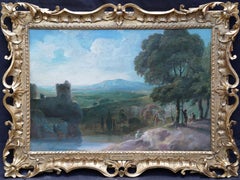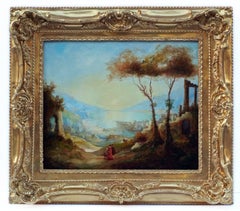Items Similar to Tribesmen beside ruins at Pinara, Lycia, c. 1844
Want more images or videos?
Request additional images or videos from the seller
1 of 12
William James MullerTribesmen beside ruins at Pinara, Lycia, c. 18441844
1844
$10,193.98
£7,500
€8,781
CA$14,278.94
A$15,669
CHF 8,112.78
MX$187,570.74
NOK 101,782.92
SEK 95,758.14
DKK 65,590.10
About the Item
William James Müller
Tribesmen beside ruins at Pinara, Lycia, c. 1844
Oil on canvas
Signed indistinctly to the stretcher frame verso, ‘Wm Müller’
35.5 x 55.7 cm.; (within frame) 46.7 x 67 cm.
Unsigned
Provenance:
Private collection, United Kingdom;
With Frost & Reed, 25 April 1968, no. CR2119;
Dr Kenneth Carl Pfeiffer Smith (1910-1999), Bristol;
Sotheby’s, Torquay, 14 October 1981, lot 273;
Sotheby’s, Billinghurst, 26 January 1999, lot 119;
Gorringe’s, 11 September 2008, lot 1528;
Private collection, United Kingdom.
Archival:
Witt Library, Courtauld Institute of Art (box no. 031407)
This fluid oil sketch belongs to some of Müller’s finest works, produced during his expedition to Lycia, Asia Minor (modern-day Turkey) during the winter of 1843-44. Demonstrating his shift towards a looser, more mature style of Orientalist painting, the present work characterises a romantic palette of contrasting and complimentary hues in rich ochres, reds and blues. Particularly experimental in style, the oil study was likely executed in no more than an hour, within Müller’s encampment between meals and rest ‒ as was typical of his oil sketches painted in the field. Similar views of the Taurus range in watercolour were made in under twenty minutes. Having briefly outlined his subject in chalk or pen and ink, and arranged his palette, Müller would often take to his guitar, playing a select few dissonant notes as though tuning himself to the scene, before rapidly working an impression onto the canvas in one effort, without hesitation or pause.
Showing members of the entourage before the snow-capped range of Mount Cragus beyond, a guide gestures to the sky, while others rest on the ground, and pack donkeys take pause behind them. The brown form entering the composition from the bottom left may be that of a rifle: indeed, Müller was gifted one to hunt with by the father of his pupil, Harry John Johnson, RA (1826-1884). The work is stylistically comparable to Slave Market (Brighton and Hove Museum, FA000013), and Arabs Playing Chess (Bristol Museum, K969), painted in Egypt in 1843.
Significantly, the distinctive rectangular stone arch depicted here appears in another watercolour by Müller entitled Pinara, Lycia – The City Ruins, Mount Cragus in The Distance, which surveys the same site from a higher viewpoint [1]. A closely related sketch, Dawn at Pinara, Lycia, features different ruins in the foreground, although with similar snowcapped peaks in the distance [2]. A more developed version of that composition is held by the British Museum (BM, 1878,1228.154). Another notable work from the expedition, Rock Tombs, Tlos, Lycia: The Citadel from the South-East, a large oil painting with a similar mountainous backdrop, was once part of the Simon Sainsbury collection, having been acquired by him from Christopher Gibbs [3].
Having been invited by the archaeologist and explorer Sir Charles Fellows (1799-1860) to join him on his fourth expedition to Lycia, Müller left England on 12 September 1843, accompanied by Johnson. The party arrived in Xanthus on 1 November and, after spending the next fortnight there, travelled onwards to the ruins of Pinara at the foot of Mount Cragus. Johnson was to later recall: ‘Here for the next nine days Müller was indefatigably occupied in exploring and sketching all that time permitted; and whoever has seen the marvellous results of his nine days’ work, achieved amidst the incessant anxieties and worries of the journey, in a wild country, and upon an exposed hill-top, will readily agree in calling his energy something wonderful’ (Solly, p. 209). On their third night at Pinara, the encampment was wrecked by a ‘hurricane of rain and lightning’, as the group took shelter in the ruined tombs. It is perhaps this incident to which the present work alludes – with the central tribesman indicating an incoming tempest [4].
Müller arrived back in London from his travels on 5 May 1844, with ‘one or two hundred drawings’ which he spent the subsequent years working up (Solly, p.200). Many were exhibited in London shortly after his return, and after his death in 1845, a major posthumous exhibition of his Lycia pictures was held in Bristol; most were dispersed at his estate sale, held at Christie’s between 1-3 April 1846.
William James Müller (1812-1845):
Born in Bristol to a Prussian father, Müller spent most of his brief 33 years painting the city and its surrounding topography, including Gloucestershire and Wales. Studying between 1827-29/30 under the landscape painter James Baker Pyne, a successful follower of Turner, Müller witnessed the chaos of the 1831 Bristol Riots aged 19 alongside his master, and painted outstanding scenes of the fiery destruction. He first exhibited at the Royal Academy in 1833, and the following year visited France, Switzerland, and Italy. He made a tour of the Middle East in 1838-39, and settled in London following his return. It was about this time that he was introduced to David Cox Senior by their mutual friend, watercolorist George Arthur Fripp, and began teaching him in watercolour.
In 1843, he was employed to complete some of Constable’s pictures for a London dealer. Müller revisited the Middle East between 1843-44, during which he painted the present work. The brief years subsequent to the expedition were spent working on Lycian views, for which he became highly regarded. He died from tuberculosis on 8 September 1845. Despite the abrupt ending to his artistic career, the remaining body of works is testament to Müller’s energy and artistic enthusiasm: ‘I must paint to live ‒ well then I paint one picture for the world & money ‒ also will I paint one for myself. Let that one be for Eternity’ (Greenacre, p.12).
Bibliography and further reading:
Cyril E. Gaunt, The Life and Work of William James Müller of Bristol (Leigh-on-Sea: F. Lewis, 1948)
Francis Greenacre and Sheena Stoddard, W. J. Muller, 1812-1845 (Bristol: Friends of Bristol Art Gallery, 1991)
Nathaniel Neal Solly, Memoir of the Life of William James Müller (London: Chapman and Hall, 1875)
Sotheby’s, London, The Bill Thomson Collection of Paintings, Watercolours and Drawings by William James Muller (1812-1845) (London: Sotheby’s, 25 November 1999)
Notes:
[1] See Sotheby’s, London, 15th November 1999, lot 78
[2] See Sotheby’s, London, 6th July 2016, lot 327
[3] See Christie’s, London, 18 June 2008, ‘Simon Sainsbury: The Creation of an English Arcadia’, lot 366
[4] W. J. Müller, ‘Letter from Xanthus’, Art-Union, February 1844, p.42
- Creator:William James Muller (1812 - 1845, British)
- Creation Year:1844
- Dimensions:Height: 18.39 in (46.7 cm)Width: 26.38 in (67 cm)
- Medium:
- Movement & Style:
- Period:
- Condition:
- Gallery Location:Maidenhead, GB
- Reference Number:1stDibs: LU2820217090982
About the Seller
No Reviews Yet
Vetted Professional Seller
Every seller passes strict standards for authenticity and reliability
Established in 2024
1stDibs seller since 2024
- ShippingRetrieving quote...Shipping from: Maidenhead, United Kingdom
- Return Policy
Authenticity Guarantee
In the unlikely event there’s an issue with an item’s authenticity, contact us within 1 year for a full refund. DetailsMoney-Back Guarantee
If your item is not as described, is damaged in transit, or does not arrive, contact us within 7 days for a full refund. Details24-Hour Cancellation
You have a 24-hour grace period in which to reconsider your purchase, with no questions asked.Vetted Professional Sellers
Our world-class sellers must adhere to strict standards for service and quality, maintaining the integrity of our listings.Price-Match Guarantee
If you find that a seller listed the same item for a lower price elsewhere, we’ll match it.Trusted Global Delivery
Our best-in-class carrier network provides specialized shipping options worldwide, including custom delivery.More From This Seller
View AllPortrait of an Arab, with pyramids beyond
Located in Maidenhead, GB
Central European School, second half 19th century
Portrait of an Arab, with pyramids beyond
Oil on canvas
66.3 x 55.2 cm.; (within frame) 86.9 x 69.9 cm.
Unsigned
Provenance:
Privat...
Category
Mid-19th Century Portrait Paintings
Materials
Oil
A sketch of children climbing a fence
By Peter de Wint
Located in Maidenhead, GB
Peter de Wint OWS (1784-1849)
A sketch of children climbing a fence
Watercolour and graphite on paper
7 x 17.8 cm; (within frame) 26.7 x 36.5 cm.
Provenance:
Bequeathed by the a...
Category
18th Century English School Landscape Drawings and Watercolors
Materials
Watercolor
$2,283 Sale Price
40% Off
Cinder
Located in Maidenhead, GB
Joel Tomlin (b. 1969)
Cinder, 2004
Oil on linen
Signed and titled verso
183 x 157 cm.
Provenance:
Joel Tomlin;
MW Projects, London, 2004;
Permanent Collection, Saatchi Gallery;
Chri...
Category
Early 2000s Contemporary Landscape Paintings
Materials
Oil
$7,067 Sale Price
20% Off
Watercolour study of a resting infant, possibly the artist's daughter
By William Henry Hunt
Located in Maidenhead, GB
William Henry Hunt OWS (1790-1864) (attrib.)
Study of a resting infant
Watercolour and graphite heightened with zinc oxide on paper
13.9 x 18.5 cm.; (within frame) 31.1 x 25.6 cm.
Un...
Category
Mid-19th Century Victorian Portrait Drawings and Watercolors
Materials
Watercolor
The Virgin and Child with the Infant Baptist
By Andrea Del Sarto
Located in Maidenhead, GB
Florentine, mid-16th century
Circle of Tomaso D’Antonio Manzuoli, known as Maso da San Friano (1536-1571)
The Virgin and Child with the Infant Baptist
After Andrea del Sarto (1486-1...
Category
15th Century and Earlier Renaissance Figurative Paintings
Materials
Oil
$15,875 Sale Price
27% Off
Portrait of a Gentleman, traditionally identified as Edward Addison, Esq., 1780s
By George Romney
Located in Maidenhead, GB
George Romney (1734-1802)
Portrait of a Gentleman, traditionally identified as Edward Addison, Esq., c.1780s
Oil on canvas
In a period carved and gilded swept frame
76.3 x 63.2 cm.; ...
Category
1780s Old Masters Portrait Paintings
Materials
Oil
You May Also Like
19thC. Figures Hunting Classical Ruins Mountainous Sunset Landscape North Africa
By Continental School
Located in Cirencester, Gloucestershire
Continental, 19th Century
oil on canvas, framed
Monogrammed 'WM' and dated '1868' lower right
framed: 34 x 48.5 inches
canvas : 29.5 x 44 inches
Provenance: private collection, UK
Co...
Category
19th Century Old Masters Landscape Paintings
Materials
Oil
Fine Victorian Grand Tour Oil Painting Travellers at Temple of Vista at Tivoli
Located in Cirencester, Gloucestershire
Artist/ School: English School (19th Century), inscribed verso
Title: The Temple of Vista at Tivoli.
Medium: oil on artists board, framed
Framed: 13 x 16 inches
Painting: 9 x 12....
Category
19th Century Victorian Landscape Paintings
Materials
Oil
Landscape with Ruins and Figures - British 18thC Old Master art oil painting
By Richard Wilson
Located in Hagley, England
This superb British 18th century Old Master oil painting is attributed to circle of noted landscape artist Richard Wilson. Painted circa 1750 it is a stunning light, bright and airy expansive panoramic landscape. There is a river in the foreground and mountains in the background. On the left of the river stands some ruins and on the right, figures are resting under the trees. The palette of blues, greens and very varied and rich with some lovely pinky brown tones for the land on the right. The brushwork is also delicate but confidently executed. A superb example of a British Old Master landscape oil painting, finished off in a carved and gilt wood English Rococo frame with name plate.
Provenance. The Asbjorn Lunde Foundation, Inc. Throughout his long life, Mr. Lunde supported more than forty museums in his native New York, across the United States, and in Europe with loans, gifts, and funding. Mr. Lunde was a proud New Yorker with roots in Norway. He was keenly interested in nineteenth-century Scandinavian and Swiss landscape painting, Old Master painting, and Asian decorative arts.
According to an old label to the reverse, the present painting was once owned by James Northcote (1746-1831) who gave it to William Hillman on 25th May 183(0?)
Property of the Bacot family.
Christies stamps verso.
Watson Gallery London. Remains of label verso.
Condition. Oil on canvas, 26 inches by 18 inches and in good condition.
Frame. Housed In a carved and gilt wood English Rococo frame bearing Richard Wilson name plate, 33 inches by 25 inches and in good condition.
Richard Wilson RA...
Category
1750s Old Masters Landscape Paintings
Materials
Oil
$23,921 Sale Price
20% Off
Painting 19th Century Landscape Antique Ruins
By Alfred August Felix Bachman
Located in Saint-Ouen, FR
BACHMANN Alfred Félix August (1863-1956)
Walking by the Antique Ruins
Oil on canvas signed low right
Frame gilded with gold leaves
Dim canvas : 54 X 65 ...
Category
Late 19th Century Academic Landscape Paintings
Materials
Oil
Figures by a Bridge with Town and Mountains in Cava Tirreni
Located in GB
This charming landscape depicts a woman seated on a donkey accompanied by a man walking alongside her, making their way along a rustic pathway. Just beyond, a stone bridge leads the ...
Category
Early 19th Century Landscape Paintings
Materials
Canvas, Oil
Fine 1900's French Impressionist Oil Painting Travellers Admiring Ancient Ruins
Located in Cirencester, Gloucestershire
Admiring the Ancient Ruins
by Etienne Auguste Krier ( 1875 - 1953)
oil on board, framed
framed: 10.5 x 7.5 inches
board: 8 x 6 inches
Provenance: private collection, Paris
Condition...
Category
Early 20th Century Impressionist Landscape Paintings
Materials
Oil
